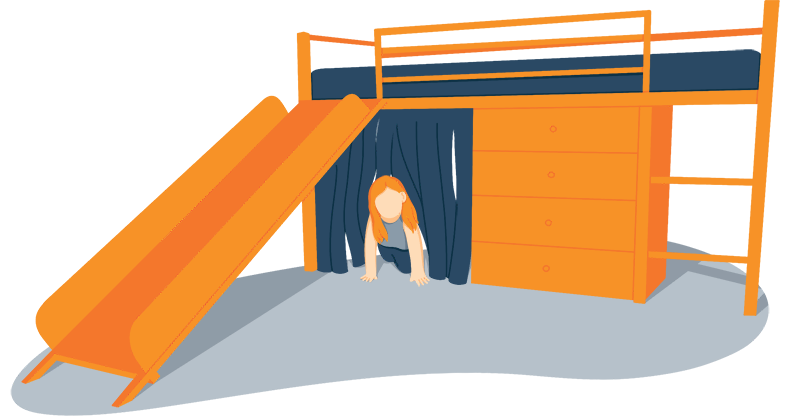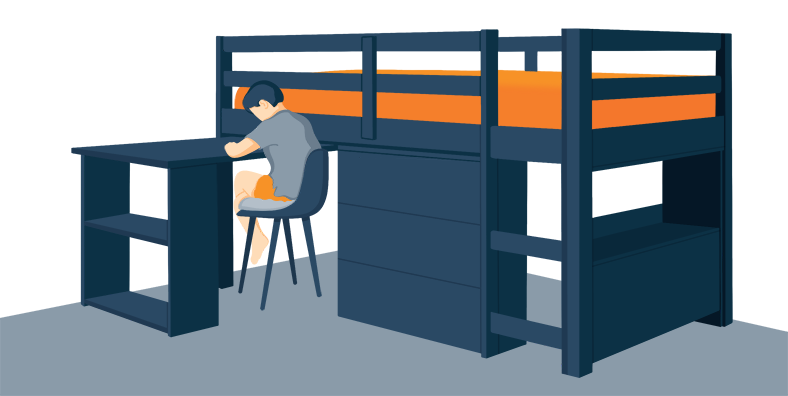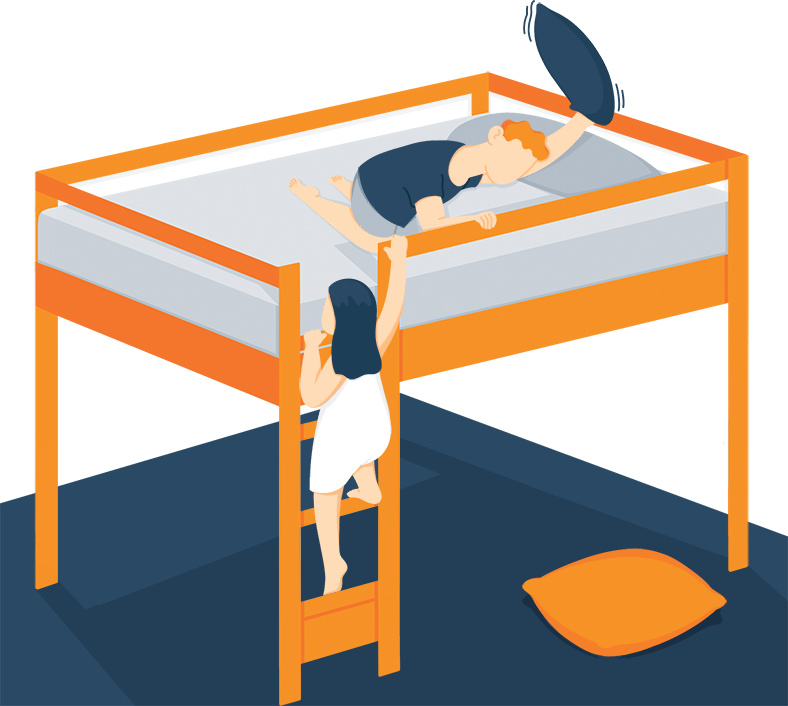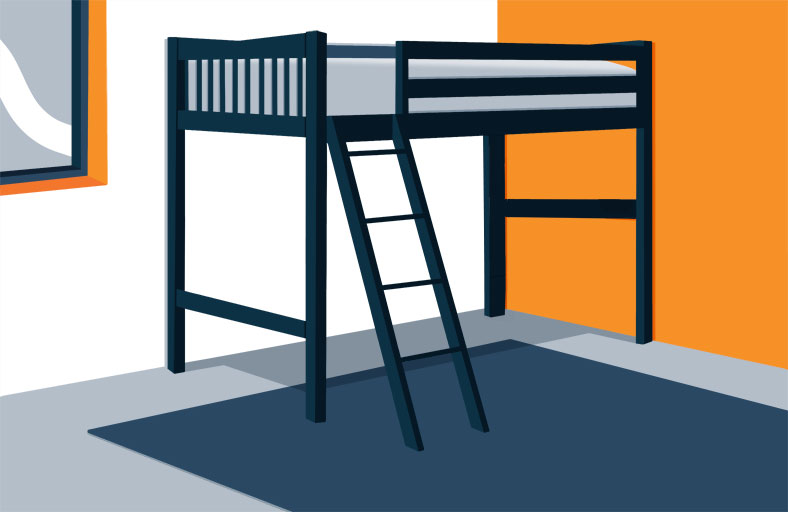Sleeping in a lofted bed can maximize floor space and create more privacy in a shared bedroom. However, if your loft bed feels unstable, you may fear that it will come toppling down while you sleep.
While a wobbling loft bed typically doesn’t indicate an impending collapse, it can create excessive noise every time you turn over. Additionally, worrying about your bed’s stability throughout the night can prevent you from sleeping soundly.
Why Is My Loft Bed Unstable?
A loft bed can feel unsteady for numerous reasons. To understand why your loft bed is wobbling, you should first look at what gives your bed its structure.
Typically, loft beds have an upper frame on which the mattress sits, four L-shaped legs, and a lower frame or support beam. Often, these parts of the bed attach with bolts or screws.
If even one of the bolts in your bed is a little loose, it can create a gap between the leg and the bed frame. Then, every time you shift or turn in bed, that movement can lead the posts to thump against the frame, causing the bed to wobble and create a knocking noise.
9 Easy Tips & Tricks to Make Your Loft Bed Sturdy
While a loose bolt is often the culprit behind a wobbly loft bed, sometimes the exact cause isn’t clear. If that’s the case, here are nine tips to make your loft bed feel sturdier.
1. Install Loft Bed Rails
Sometimes, loft beds shake and feel unstable because they do not have the proper structure surrounding their frames. One way to give the bed frame more stability is to brace the legs by installing an additional railing around the bed.
If your bed frame is wooden, you can easily create a rail using solid wood planks. Simply cut two planks to the bed’s width and two to its length and attach them around the top of the bed frame using a drill and screws.
Not only will this railing give the bed more support, but it can also prevent you or the bed’s occupant from falling out.
2. Get Thicker Bed Posts
If your loft bed’s legs or posts are relatively skinny, they may not provide enough structure and support for the bed frame and mattress, making it feel wobbly. Replacing these legs with thicker ones, or building onto these posts, can enhance your bed’s overall sturdiness.
If you’d rather not replace the legs entirely, one way to make them sturdier is to add shelving units onto the bedposts. Building shelves into the legs can increase the bed’s functionality and create additional storage in the room while making the loft feel sturdier.
However, you can also simply attach wood or metal planks to the legs to make them thicker and improve their support.
3. Secure the Loft Bed to the Wall
If you’ve tried a few solutions and your loft bed is still wobbly, your next move may be to secure it to the wall. Attaching the bed to the wall allows it to use the wall as support and gives it less room to wobble.
To give the bed the most support, we recommend placing it in the corner of the room so that you can attach the head and side to the wall. You can follow these steps to secure the bed to the wall:
- Locate the wall stud.
- Drill holes into the bed frame adjacent to the wall stud.
- Screw the bed frame to the wall using lag screws.
4. Teach Your Children to Respect the Rules in the Bed
A loft bed’s nuts and bolts can loosen with excessive movement. If your children jump on the bed regularly, they could shake these bolts loose and split the wood, impacting the bed’s sturdiness and even rendering it unsafe.
One way to prevent your loft bed from becoming unsteady is to teach your children not to jump and climb around on the bed. They should use their bed for sleeping, relaxing, and quiet activities— not as a jungle gym. If they cannot handle this responsibility, we recommend switching them to a traditional bed until they are a little older.
5. Install Feet on Your Loft Bed
Loft beds often use skinny legs and feet to fit in small spaces and maximize their storage underneath. However, these legs sometimes do not create the necessary structural support for the upper bed frame and mattress.
Installing feet on your bedposts can increase surface contact with the floor, making the bed sturdier and less wobbly. You can purchase bed frame feet at most hardware stores and major retailers like Walmart.
To maximize the benefits from these feet, be sure to choose ones that are wider than your bedposts and that allow the bed’s legs to fit snugly into them.
6. Choose Solid Tubes
Some metal bunk beds use hollow legs and rails rather than solid ones. While hollow tubes make the bed lighter and easier to transport, they tend to create less supportive frames. Replacing these posts with solid ones can give the bed a sturdier structure and reduce wobbling.
If you think your hollow metal posts are the sole cause of your loft bed’s instability, purchasing a new bed with more supportive framing may be easier than replacing the posts. As you search for a new bed, be sure to look for one that uses solid bars for weight-bearing portions of the frame, such as the bed’s legs and the ladder rungs.
7. Always Disassemble Your Loft Bed Before Moving It
If you’re planning to move your loft bed to a new room or residence soon, you should make sure to disassemble the bed before transporting it. Moving the bed as a whole unit could loosen the bolts or cause the wood to crack. Additionally, because the structure is so large, you risk banging it into the walls or doors during transport.
Before you disassemble your loft bed, we recommend taking several close-up photos of it to jog your memory when you reassemble it. Putting the bed back together correctly is important, as you want to make sure the bolts and nuts are tight and secure to prevent the bed from wobbling.
8. Do a Monthly Checkup and Tightening
Even if you are gentle with your loft bed and reduce excessive movement, the bed’s bolts and nuts can loosen over time with regular use. Tightening these bolts every month can prevent the bed from becoming too wobbly and keep the frame secure and safe.
During this monthly tune-up, you should also spend time examining the metal or wood frame and looking for cracks or bends that could impact the bed’s stability. Catching these issues early will allow you to repair them before the bed becomes unsafe. If you cannot fix the problem, you may need to purchase a new loft bed.
9. Check the Humidity
If your loft bed uses a wooden frame, humidity may be the culprit behind your squeaky, unstable bed. Wood tends to expand slightly in humid environments and shrink in dry spaces, and this constant growing and shrinking can loosen your bed’s joints, affecting its stability.
You can check the humidity of your room using a wood moisture meter from any hardware store. Simply hold the meter against the wood frame and wait for the reading. If the meter reads above 8%[1], we recommend placing a dehumidifier in the room to lower your moisture levels and keep them stable.
Find Out More: Best Loft Beds on the Market
Frequently Asked Questions
Are loft beds safe and good for you?
With the proper structure and support, loft beds are just as safe as traditional beds. These beds are common in college dorm rooms and shared spaces like children’s bedrooms. Most often, their occupants do not have any problems with them.
However, if you tend to shift around a lot in your sleep—or if you have rolled out of your bed in the past—you may want to opt for a loft bed that includes side railings. Additionally, we do not recommend these beds for children under six, as younger kids may have trouble safely climbing in and out of lofted beds.
Get More Info: Are Loft (Bunk) Beds Safe For Kids & Toddlers?
Conclusion
A swaying, wobbly loft bed can put a damper on some of the advantages of using this type of bed within your home. Typically, loft beds feel unsteady because their bolts are loose or they do not have a wide enough structure to support the heavy bed frame and mattress.
Making a few changes to your bed, such as adding wider legs or feet and securing the loft bed to the wall, can help keep it firmly planted in a safe, steady position. Once you finish implementing the above solutions, you’ll be able to appreciate the extra storage and privacy that comes with sleeping in a loft bed.
Sources and References:
- [1] “Acceptable Moisture Levels In Wood – Knowing The Misture Content“, Wagner Meters, November 8, 2021

Julia Forbes
Lead Product Tester
About Author
Julia is the Lead Reviewer at Sleep Advisor, specializing in testing out mattresses and sleep accessories – she’s in the right line of work, because she loves to sleep.
Stomach Sleeper




